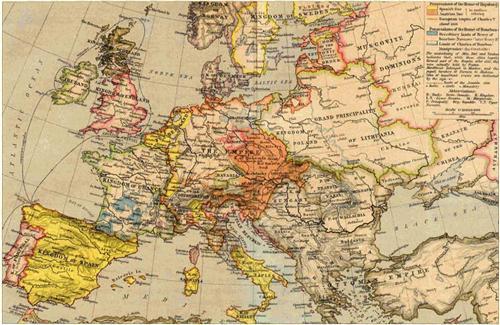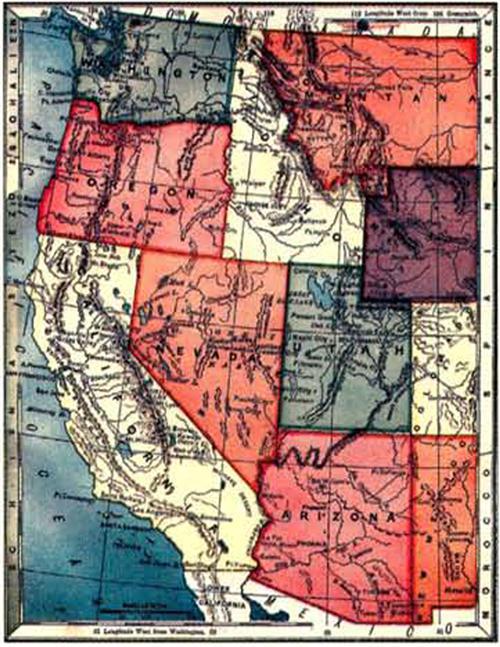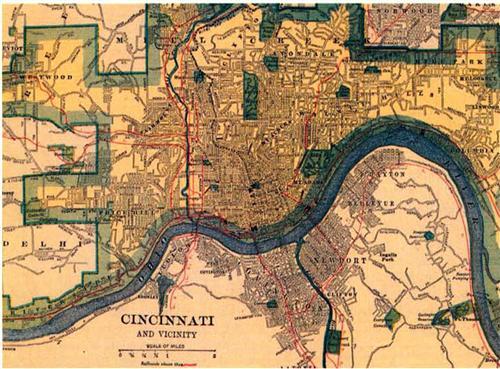Sign up for the Family Tree Newsletter Plus, you’ll receive our 10 Essential Genealogy Research Forms PDF as a special thank you!
Get Your Free Genealogy Forms
"*" indicates required fields

Correctly identifying the places your ancestors lived isn’t an obstacle just in European genealogy — it can be tricky even in more-familiar US locales. As new areas were settled, many towns and counties were renamed, and county borders changed frequently. Some towns have disappeared altogether. I live just a mile from a place once known as Stock wood. A hundred years ago, it had a general store, a boardinghouse, a post office, a railroad depot and a one-room school. Today, only the school building remains (it now serves as the township hall), and Stock-wood hasn’t appeared on maps for years.
Fortunately, you don’t have to navigate your family tree’s geography without guidance. Maps and gazetteers (geographical dictionaries) can help you find obscure places, learn about boundary changes and better understand your ancestors’ surroundings. And like so many other family history resources, maps and gazetteers have gone high-tech: You now can turn to the Net for tools to plot your family’s past. Of course, you need to know the best places to log on, so we’ve rounded up the 56 best online mapping tools for genealogy. A few quick clicks on these Web sites may generate answers to your geographical conundrums — or at least get your research moving in the right direction.
The Worldwide Web
Ancestry.com <www.ancestry.com>
Subscribers can access gazetteers for the United States, England, Ireland, Scotland and Wales. Click on Search Records, then Reference & Finding Aids.
Bartleby.com: Columbia Gazetteer <www bartleby.com
This gazetteer has information on 50,000 places in Canada, Mexico, the United States and the Caribbean.
FamilySearch <www.familysearch.org >
The Church of Jesus Christ of Latter-day Saints’ popular genealogy Web site has two helpful tools for tracing ancestral locations:
? Family History Library catalog (FHLC). From the FamilySearch home page, select the Search tab, then Family History Library Catalog. In addition to helping you identify materials in Salt Lake City that you can borrow through a branch Family History Center in your community (see <www.familysearch.org/eng/Library/FHC/frameset_fhc.asp> to find the one nearest you), the FHLC also can help you identify the county where a town is located. Just click on Place Search, and type the name of the town in the Place box and the state in the “Part of” box. You also can search on foreign places, but the FHLC includes only localities covered by the Family History Library’s collection.
Search on a county name, and the catalog notes will tell you the year it was formed and the parent counties’ names — so you’ll know where to look for records before that date.
You can get a list of towns in a county, too. Search on the county, and then click on View Related Places to display a list of the county’s towns.
? Maps. On the Search tab, click Research Helps. Then, select Sorted by Document Type, followed by Map. These simple outline maps show state, province and national borders, as well as large cities.
Getty Thesaurus of Geographic Names Online <www.getty.edu/research/conducting. research/vocabulanes/tgn>
With more than a million names — including historical places — the Getty Thesaurus focuses on important art and architecture locations. Search on your ancestral homeland, and you’ll get its geographic coordinates, spelling variations and foreign-language equivalents (such as the German München for Munich or the Italian Firenze for Florence), and cultural information.
Global Gazetteer <www.calle.com/world>
Organized by country, this directory links to maps for more than 2.8 million cities and towns.
Heavens Above <www.heavens.above.com>
Search more than 2 million worldwide town names. When you locate your destination, click on Neighbours to get a list of the closest surrounding towns.
Infospace <www.infospace.com>
Online phone directories can help you find more than just long-lost relatives. Select Find a Business by Type, type churches or cemeteries in the Type of Business box, fill in a town and state, then click on Search. Hit Details beside an address to display a map pinpointing the site. Other directories such as Switchboard.com <www.switchboard.com> and Lycos Yellow Pages <yp.lycos.com> have similar capabilities.
Mapquest <www.mapquest.com>
This tremendous tool can create a map of almost any place on earth. Just click on Maps and fill in the names of the city and country. You can zoom in or out to view neighboring towns, as well as print or e-mail the map.
MSN Maps &, Directions <mappoint.msn.com>
Similar to MapQuest, this site maps locations around the world.
Multimap.com <www.multimap.com>
Like MapQuest, Multimap.com shows maps of localities in almost every country.
Perry-Castañeda Library Map Collection <www lib.utexas.edu/maps>
The University of Texas at Austin library’s geographical goodies include present-day and historical US and foreign maps.
Maps Across America
County Location of New England Place Names <neatlas.hah.harvard.edu/NECounty>
Digital Sanborn Maps 1867-1970 <sanborn.umi.com>
Libraries subscribing to this service provide online access to more than 660,000 large-scale maps of more than 12,000 American towns and cities. The maps even show the dimensions of individual homes.
Genealogy.com: Family and Local Histories <www.genealogy.com>
Subscribers get access to digital images of thousands of books, including atlases of New York and Pennsylvania counties and many county and state gazetteers. A subscription to this collection costs $14.99 per month or $79.99 per year.
Historical County Lines <jrshelby.com/hcl>
This site has links to county and state maps from Colonial times to the 20th century.
Rootsweb County Finder <resources.rootsweb.com/usa>
Find the county for a US town or city.
United States Digital Map Library <www.rootsweb.com/-usgenweb/maps>
This growing collection includes historical maps of states, counties and townships.
Us County Formation Maps 1643-Present <www.genealogyinc.com/maps/uscf.htm>
This especially useful site features maps showing the evolution of county boundaries in Eastern states.
USgenweb <www.usgenweb.org>
Click on The Project’s State Pages for links to state and county pages, some with historical and modem maps.
USGS Geographic Names Information System (GNIS) <geonames.usgs.gov>

State-By-State Sites
Alabama Maps <alabamamaps.ua.edu>
This Web site features more than 4,000 maps dating from Colonial times to the present. They cover several Southeastern states, not just Alabama.
Colorado Places by County <www.rootsweb.com/-coyuma/city>
Log on to learn a city or town’s parent county — even if that place no longer exists.
Historical Atlas of Georgia Counties <www.cviog.uga.edu/Projects/gainfo/histcountymaps>
Each county page has a series of maps dating from as far back as the 18th century.
Illinois County Boundaries 1790-Present <www.rootsweb.com/-ilcumber/ilctybnd>
This 29-map series shows the state’s changing county borders.
Kentucky Atlas and Gazetteer <www.uky.edu/KentuckyAtlas>
Find your family’s old Kentucky home in this gazetteer, which contains 100,000 names of places, streams and roads, all linked to maps.
Minnesota Place Names <mnplaces.mnhs.org/upham>
Search on the name of a village, township, lake or stream, and this site will tell you the county where it’s located, plus the history of its name.
New Jersey (and Pennsylvania) Place Names <www.genealogy-quest.com/collections/njplace.html>
You’ll find dozens of cities’ former and current names here — and perhaps clues to why a town changed its moniker: Renaming Poverty Hill to Robbinsville, for example, certainly made it sound like a more auspicious place to live.

Look up cities, townships, cemeteries, churches and historical place names to find out which counties they’re in. The Changed Place Names feature is especially helpful.
Oregon County Boundary Changes <arcweb.sos.state.or.us/county/cpmapboundary.html>
These maps show the evolution of the state’s counties from 1843 to 1893.
Tennessee Place Names and Post Offices <www.state.tn.us/sos/statelib/pubsvs/postoff.htm>
This list shows each post office, its dates of operation and the county where it was originally located.
The Virginia Gazetteer <fisher.lib.virginia.edu/collections/gis/vagaz>
This database contains information on 51,000-plus geographic features, including cemeteries, churches and schools. To get a list of these geographic features in a particular county, do a Feature Search, select Cemetery, Church or School as the Feature Type, and choose a county.
Washington Place Names Database <www.tpl.lib.wa.us/v2/nwroom/wanames.htm>
Search on a place name to find out its parent county and read a brief description.
Wisconsin County Maps <wwwdot.state.wi.us/travel/maps/county.htm>
These downloadable PDF maps show town ships. (You’ll need the free Adobe Reader, which you can get at <www.adobe.com/products/acrobat/readstep2.html>.
Canadian Cartography
The Canadian County Atlas Digital Project <digital.library.mcgill.ca/countyatlas>
This searchable database of property owners links to town maps and pictures from atlases published between 1874 and 1881.
Geographical Names of Canada <geonames.nrcan.gc.ca>
Search on the name of a town or a geographic feature, such as a river, lake or mountain. This database will give you the province and show the Location on a map.
European Navigation
Belgian Place Names <belgium.rootsweb.com/bel/_places>
Discover a place’s municipality, province and variant names.
Geoserv <www.genealogienetz.de/misc/geoserv.httnl>
E-mail the name of a German town or village, and you’ll receive a reply with information on the town, including its county and population.
Horlacher Genealogy Site <www.horlacher.org>
This useful site covers several countries: One section outlines Danish parishes, their districts and counties. The German Street Guide lists street names (and the parishes in which they’re found) by city. Historical maps show the changing boundaries in Denmark, Germany, Hungary, Poland and Romania.
Institut Géographique National <www.ign.fr>
Under e-Services, click on Localisation Géodésie and enter the name of a French town (commune) in the box. Then click on Localiser followed by the town’s name, and you can see the town’s geographic coordinates and order related maps.
The Jewishgen Shtetlseeker <www.jewishgen.org/shtetlseeker>
Anyone with roots in Central or Eastern Europe can benefit from this site. The data-base includes historical place names and links to maps from MapQuest. Once you find your town, you can perform a search for other towns within a specified distance of its location.
Luxembourg Gazetteer of Villages and Towns <www.igd-leo.lu/igd-leo/onomastics/villages/villages.html>
Luxembourg place names typically have different spellings in French, German and Luxembourgish, so this site has alphabetical lists of towns in all three languages. Each entry gives the name of the local community (commune) for the town’s administration.
Mapsite: National Land Survey of Finland <www.kartta.nls.fi/karttapatkka/eng/home.html>
After registering (it’s free), click on Nimet ja Osoitteet, type a place name in the box and click on Suorita haku. Then click on the match to view a map. The most-detailed maps — part of the Professional’s MapSite — require a $35 to $250 fee (based on the number of searches).
Norway <kart.norge.no>
Select Søk Stedsnavn (place-name search) from the pull-down menu. Choose a county or I alle fylker (all counties), enter a kommune (municipality or township) or a navn (place name) and click on søk (search). Then press kart to display a map.
Place Names in Denmark <levende kms.dk/su/sunavn.htm>
Under Navnedata i PDh-format, you’ll find tour links to PDF files containing alphabetized place-name lists, which indicate each place’s (stedhavn) parish (sogn).
Poland <www mapapolski.pl>
Type a place name in the box and click on Pokaz to display a map.
Scandinavia: Nordic Place Names Database <www.kartta2.nls.fi/nondb/nrr>
Register for free to access a database covering places in Denmark, the Faeroe Islands, Finland, Greenland, Norway and Sweden.
The Swedish Gazetteer <www.sna.se/gazerteer.html>
If you search on a place, the Swedish Gazetteer will find its municipality and county, as well as plot its location on a national map.
Best of the British Isles
Gazetteer for Scotland <www.geo.ed.ac uk/scotgaz>
This gazetteer covers not only towns and villages, but also histories of family names and biographies of famous people associated with Scotland. A profile usually covers the town’s location, history and industries, and includes a photograph.
Gazetteer of British Place Names <www.gazetteer.co.uk>
This database lists more than 50,000 hamlets, villages, towns and cities in England, Scotland and Wales, and gives the county where each one is located.
GENUKI <www.genuki.org.uk>
GENUKI’s county pages include many handy maps and gazetteers. For example, the Devon page has a gazetteer with the names of 12,000 places, including chapels, churches, farms, hamlets, houses, inns, manors, schools, streets and villages. The Devon page also has several excellent maps showing parish boundaries.
And don’t miss these two resources:
? Counties of England, Wales and Scotland Prior to the 1974 Boundary Changes <www.genuki.org.uk/big/Britain.html>: The pre-1974 county boundaries determine where you’ll find most records useful for genealogy.
? GENUKI Parish Database <www.genuki.org.uk/big/parloc/search.html>: This is a database that identifies the nearest parishes and churches to your English, Scottish or Welsh ancestor’s hometown.
IreAtlas Townland Database <www seanruad.com>
Get a list of parishes or baronies in a county.
The National Gazetteer of Wales <www.gazetteer-wales.co.uk>
This list of more than 6,000 places includes both English and Welsh spellings.
Ordnance Survey: Get-A-Map <www.ordnancesurvey.co.uk/getamap>
This online version of the wonderfully detailed Landranger maps of England, Scotland, Wales and Northern Ireland even shows houses and farms by name (you can’t search on those names, though).
Otherdays.com <www.otherdays.com>
The many Irish resources here include a database of Irish place names and Ordnance Survey maps covering 1824 to 1846, Subscription costs range from $8 for 72 hours of access to $44 for a year. Note: This site is no longer available, but you can order Ordnance Survey maps from <www.irishmaps.ie>.
Scottish Place-Name Society: Scottish Parishes <www.st-andrews.ac.uk/institutes/sassi/spns/parishlist.htm>
This list includes the parish name, parish number and county.
Streetmap.co.uk <www.streetmap.co.uk>
Like the Ordnance Survey site, Streetmap locates a place on a Landranger map of England, Scotland or Wales (but not Northern Ireland). This site’s advantage: Streetmap does support searches on house and farm names.
From the April 2004 Family Tree Magazine
ADVERTISEMENT

